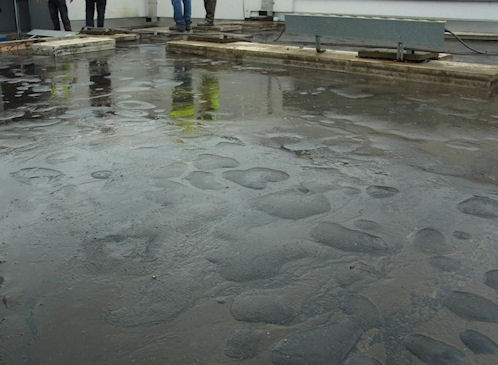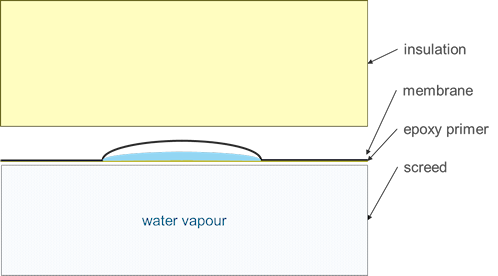Inverted roof defect - case study
An inverted roof, also referred to as a ‘protected membrane’ or ‘upside down’ roof, is where the waterproofing layer is beneath the thermal insulation layer instead of above it. This means that the temperature within the roof void is closer to that of the building’s interior, without a vapour control layer being required as with a warm roof.
BRE investigated a large building with an inverted roof that was suffering from persistent leaks, with water dripping from the underside of the roof and on to suspended ceiling tiles. When the insulation was removed from the worst-affected area, a large number of water-filled ‘blisters’ were found in the waterproof membrane.
The blisters ranged in size from 50 mm to 1 m and further investigations revealed that they were present across the entire building.
[Figure 1 – Water-filled blisters across roof surface revealed by the removal of the insulation boards]
The roof build-up comprised the following elements:
- Ballast.
- Insulation.
- Liquid-applied polyurethane waterproof membrane.
- Epoxy resin primer.
- Concrete screed.
- Pre-cast concrete planks.
The building owners assumed that the blisters had formed because of pinholes and small tears in the membrane, and indeed many such defects were present. However, the majority of the blisters did not contain any defects and there appeared to be no path for water to enter them.
Following an investigation, BRE concluded that water that had been trapped in the roof build-up during construction had condensed between the top of the concrete screed and the underside of the membrane.
The epoxy primer that had been applied to the top of the concrete screed appeared to be acting like a one-way valve, allowing water vapour to pass upwards, but not allowing it to be absorbed back into the screed once it had condensed. This caused the blisters to be ‘pumped up’ with water each time a sudden downpour followed a spell of fine weather.
[Figure 2 – Sketch of condensation within a vapour-filled blister]
It is stressed that this was an unusual occurrence and not one that is normally associated with inverted roofs. Unfortunately the scope of the investigation did not allow BRE to fully investigate the circumstances that had allowed the blisters to form. But the most likely cause was a deficiency in the bond between the liquid-applied waterproof membrane and the primed surface of the concrete screed.
This article was originally published here by BRE.
[edit] Find out more
[edit] Related articles on Designing Buildings Wiki
Featured articles and news
RTPI leader to become new CIOB Chief Executive Officer
Dr Victoria Hills MRTPI, FICE to take over after Caroline Gumble’s departure.
Social and affordable housing, a long term plan for delivery
The “Delivering a Decade of Renewal for Social and Affordable Housing” strategy sets out future path.
A change to adoptive architecture
Effects of global weather warming on architectural detailing, material choice and human interaction.
The proposed publicly owned and backed subsidiary of Homes England, to facilitate new homes.
How big is the problem and what can we do to mitigate the effects?
Overheating guidance and tools for building designers
A number of cool guides to help with the heat.
The UK's Modern Industrial Strategy: A 10 year plan
Previous consultation criticism, current key elements and general support with some persisting reservations.
Building Safety Regulator reforms
New roles, new staff and a new fast track service pave the way for a single construction regulator.
Architectural Technologist CPDs and Communications
CIAT CPD… and how you can do it!
Cooling centres and cool spaces
Managing extreme heat in cities by directing the public to places for heat stress relief and water sources.
Winter gardens: A brief history and warm variations
Extending the season with glass in different forms and terms.
Restoring Great Yarmouth's Winter Gardens
Transforming one of the least sustainable constructions imaginable.
Construction Skills Mission Board launch sector drive
Newly formed government and industry collaboration set strategy for recruiting an additional 100,000 construction workers a year.
New Architects Code comes into effect in September 2025
ARB Architects Code of Conduct and Practice available with ongoing consultation regarding guidance.
Welsh Skills Body (Medr) launches ambitious plan
The new skills body brings together funding and regulation of tertiary education and research for the devolved nation.
Paul Gandy FCIOB announced as next CIOB President
Former Tilbury Douglas CEO takes helm.
UK Infrastructure: A 10 Year Strategy. In brief with reactions
With the National Infrastructure and Service Transformation Authority (NISTA).

























